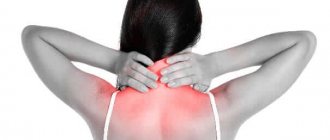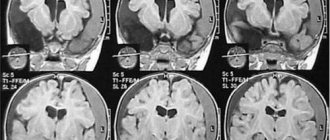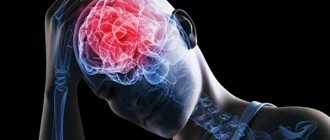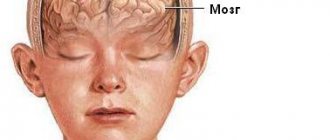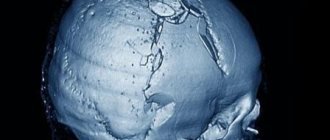Head injuries include damage to the skin, subcutaneous tissue, muscles, skull bones and brain matter. These are particularly dangerous injuries for the human body, since soft tissue injuries are often accompanied by heavy bleeding, and bone fractures are complicated by brain damage, which in injury statistics accounts for half of all injuries. A quarter of the victims die from cardiac arrest due to untimely or ill-provided medical care.
Causes of head injuries
Head injuries occur as a result of such events:
- • injuries in everyday life, fights;
- • injuries at work;
- • use of firearms;
- • injuries during an accident.
Classification of head injuries
The following types of head injuries are distinguished:
- injury to the skin, subcutaneous tissue, muscles,
- fractures of the skull bones.
All injuries can be closed (bruise) or open (wounds). There are also fractures of the skull (vault and base) and facial skull (the most common are fractures of the upper and lower jaw, the temporal bone).
Complications
Some of the possible complications of a concussion are:
- Post-traumatic headaches. Some people experience concussion-related headaches for up to seven days after the brain injury.
- Post-traumatic dizziness. Some people experience a spinning sensation or dizziness for days, weeks, or months after a brain injury.
- Post-concussion syndrome. A small proportion of people (15% to 20%) may have symptoms such as headaches, dizziness and trouble thinking that last more than three weeks. If these symptoms persist for more than three months, it is considered post-concussion syndrome.
- Cumulative effects of various brain injuries. Active research is currently underway to examine the effects of repeated head trauma that does not cause symptoms (subconcussion trauma). There is currently no convincing evidence that repeated brain injuries contribute to cumulative effects.
- Second Impact Syndrome. In rare cases, a second concussion before the signs and symptoms of the first concussion have resolved can lead to rapid and usually fatal swelling of the brain. It is important that athletes do not return to sports if they are still experiencing signs and symptoms of a concussion .
Signs of head injuries
All types of head injuries have their own symptoms and mechanisms, knowledge of which will allow you to provide competent assistance to the victim at the scene of the incident. A bruise occurs when struck by a hard object. It can manifest as subcutaneous limited or diffuse hemorrhage, characterized by the presence of fluctuation (softening).
Head wounds can be penetrating (in which the dura mater is damaged) and non-penetrating (without damaging it). Depending on the wounding object, they are divided into cut, chopped, stabbed, bruised, and gunshot wounds.
Cut wounds are inflicted with a knife, blade and other sharp objects. They are accompanied by pain, heavy bleeding; their edges are even, smooth, and gape widely. Chopped wounds occur when struck by a sharp heavy weapon, deep; As a rule, the substance of the brain is damaged. Puncture wounds have a deep channel and are dangerous for the development of anaerobic infection. Bruised wounds are less dangerous, however, they are accompanied by severe damage to surrounding tissues with their further necrosis. Scalped wounds are characterized by damage to surrounding tissue and heavy bleeding. Gunshot wounds are superficial (without damage to the bone) and deep (non-penetrating and penetrating - with damage to the bone, meninges and brain substance).
Fractures of the facial bones reach 4% of skeletal fractures, but the most common are fractures of the lower jaw. With such a fracture, the following signs are determined:
- the patient has difficulty chewing and swallowing;
- the jaw is tilted to the side,
- speech is impaired,
- pain and pathological mobility of fragments are noted.
A calvarial fracture occurs after strong impacts with depression and rupture of the skull bones. It is characterized by:
- the presence of deformation, depression or protrusions,
- mobility of bone fragments and crepitus (a sound reminiscent of that heard when walking on snow in cold weather).
- with an open fracture, brain matter can be seen in the wound.
Fracture of the base of the skull appears:
- leakage of blood and cerebrospinal fluid (cerebrospinal fluid) from the nose and ear,
- symptom of “spectacles” - hemorrhage into the tissue around both eyes,
- exophthalmos (displacement of the eyeball forward).
It must be remembered that the severity of the victim’s condition will be determined not by a bone fracture, but by a traumatic brain injury.
Symptoms
Signs and symptoms when you shake your head may not be noticeable and may not appear immediately. Symptoms may last several days, weeks, or even longer.
Common symptoms after a brain injury are headache, memory loss (amnesia) and confusion. Amnesia usually involves forgetting the event that caused the concussion.
© shutterstock
Signs and symptoms of a concussion may include the following:
- Headache
- Tinnitus
- Disease
- Vomit
- Fatigue or drowsiness
- Blurred vision
Other signs and symptoms of a concussion include:
- Confusion or disorientation
- Amnesia due to a traumatic event
- Dizziness or "seeing stars"
A witness may observe the following signs and symptoms in a person who has suffered a concussion:
- Temporary loss of consciousness (although this does not always happen)
- Speak by dragging words
- Late response to questions
- Stunned look
- I forget how to ask the same question repeatedly
Some concussion symptoms may appear immediately, while others may last for several days after the injury, such as:
- Problems with concentration and memory
- Irritability and other personality changes
- Sensitivity to light and noise
- Sleep disorders
- Problems of psychological adjustment and depression
- Smell and taste disorders
Symptoms in children
Head trauma is very common in young children. But concussions can be difficult to recognize in infants and toddlers because they cannot describe what they feel. Signs of a concussion may include:
- Stunned look
- Lethargy and fatigue
- Irritability and bad mood
- Loss of balance and unsteady gait
- Excessive crying
- Changes in diet and sleep patterns
- Lack of interest in favorite toys
- Vomit
- Convulsions
When to see a doctor
Contact your doctor within 1-2 days if:
- You or your child have suffered a head injury, even if emergency medical attention is not required.
If your child has no signs of a serious head injury, remains alert, moves normally, and responds to you, the injury is likely mild and usually does not require further evaluation.
In this case, if your baby wants to take a nap, you can let him do it. If warning signs appear later, seek emergency medical attention.
© shutterstock
Get emergency medical help for an adult or child who has a head injury and signs and symptoms such as the following:
- Repeated vomiting or nausea
- Loss of consciousness lasting more than 30 seconds
- Headache that gets worse over time
- Fluid or blood from the nose or ears
- Problems with vision or vision, such as pupils that are larger than normal (dilated pupils) or different sizes
- Ringing in the ears that won't go away
- Weakness in the arms or legs
- You look very pale for over an hour
- Changes in behavior
- Confusion or disorientation, such as difficulty recognizing people or places.
- Babbling or other speech changes
- Obvious difficulties with mental functioning or physical coordination
- Changes in physical coordination, such as stumbling or awkward movements.
- Convulsions
- Prolonged or recurring dizziness
- Symptoms that get worse over time
- Large bumps on the head or bruises in areas other than the forehead in children, especially infants under 12 months.
Athletes
Never return to sports or physical activity if you have signs or symptoms of a concussion.
Experts recommend that an athlete suspected of having a concussion not return to activities associated with an increased risk of another concussion while experiencing these symptoms.
Children and adolescents should be evaluated by a health care professional trained in the assessment and treatment of concussions in children.
Experts also recommend that adults, children and teens with a concussion not return to sports on the same day as the injury.
First aid for head injury
In case of a soft tissue bruise, you need to put a bag of snow, ice or water on the victim's head. You can also moisten several layers of gauze with cold water, squeeze well and apply to the bruised area. The edges of the wound should be treated with a 1% alcohol solution of iodine or a 5% alcohol solution of brilliant green and cover it with a sterile gauze bandage; bleeding is stopped with a pressure bandage. If there are signs of fractures of the cranial vault, then the bandage is applied very carefully. Pieces of bones, metal, and fragments protruding from the wound are not removed to avoid bleeding. If brain matter is visible in the wound, do not press it down; several sterile napkins are placed on the wound, and a roller is placed around them, which is rolled up from cotton wool and gauze like a donut. A bandage should be applied on top. If the base of the skull is fractured, the victim is laid horizontally, with the head turned to the side. In case of a fracture of the lower jaw, stop the bleeding using tampons and a sterile bandage; bleeding can also be stopped by pressing the artery with a finger to the angle of the lower jaw. You can also bandage the lower jaw to the head with a sling bandage. The victim's mouth must be cleared of knocked out teeth, vomit and blood clots. If there are no wounds, apply cold to the damaged area. If necessary, perform cardiopulmonary resuscitation.
The life of a victim with a head injury depends on who is nearby at the time of the incident: a person can be saved only when the injury is recognized in a timely manner and qualified first aid is provided. After providing first aid, be sure to call an ambulance.
Features of head injury in childhood
The bone tissue of a child under 12 years of age contains a large amount of water, has a fibrous structure, and is characterized by a low content of calcium salts. The bones of the skull in childhood are soft and flexible. After a blow, a dent may appear on the child’s head; the brain matter is damaged more often due to strong mechanical impact on the skull than in adult patients.
If a child falls and hits his head, he may have a headache, an increase in body temperature, and vomiting, which suggests the need to urgently take the following actions: lay the child in a horizontal position and call a doctor. Even if the baby remains conscious, it is important to pay attention to changes in his behavior.
Affected children usually lose their appetite. They become inactive and complain of double vision. If a child feels sick after hitting his head, and signs such as apathy, lethargy, weakness, drowsiness and dizziness appear, he needs urgent medical attention.
Treatment methods
In case of a mild concussion, the patient is advised to rest in bed. If you hit the back of your head or any other part of your head, the first thing to do is call an ambulance. The doctor will assess the severity of the condition and, if necessary, carry out rehabilitation measures, which include:
- Tracheal intubation.
- Air duct insertion.
- Connection to a ventilator.
- Administration of plasma replacement solutions.
- Dehydration therapy.
If necessary, surgical intervention is performed, during which intracerebral and meningeal hematomas are removed and impaired blood flow is restored.
Consequences of a head injury
The consequences of a strong blow to the back of the head can be expressed in sleep disturbances, visual dysfunction, deterioration in performance and cognitive abilities, and the development of depression. A simple hit to the head with a ball can lead to serious consequences:
- Chronic headaches.
- Hydrocephalic syndrome, persistent increase in intracranial pressure.
- Paresis, paralysis.
- Brain abscess.
- Epileptic seizures, convulsive syndrome.
The consequences of strong blows to the head with a fist often manifest themselves in the form of intracranial bleeding, swelling of brain tissue, dislocation of brain structures, which can ultimately lead to disability or death.
A head injury, regardless of severity, can have serious health consequences. For any head injury, it is necessary to undergo a diagnostic examination and receive adequate treatment.
649


